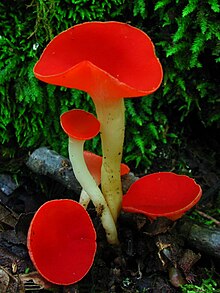| Sarcoscypha occidentalis | |
|---|---|

| |
| Scientific classification | |
| Domain: | Eukaryota |
| Kingdom: | Fungi |
| Division: | Ascomycota |
| Class: | Pezizomycetes |
| Order: | Pezizales |
| Family: | Sarcoscyphaceae |
| Genus: | Sarcoscypha |
| Species: | S. occidentalis
|
| Binomial name | |
| Sarcoscypha occidentalis | |
| Synonyms[1] | |
| Sarcoscypha occidentalis | |
|---|---|
| Smooth hymenium | |
| No distinct cap | |
| Hymenium attachment is irregular or not applicable | |
| Stipe is bare | |
| Ecology is saprotrophic | |
| Edibility is unknown | |
Sarcoscypha occidentalis, commonly known as the stalked scarlet cup or the western scarlet cup, is a species of fungus in the family Sarcoscyphaceae of the Pezizales order. Phylogenetic analysis has shown that it is most closely related to other Sarcoscypha species that contain large oil droplets in their spores. S. occidentalis has an imperfect form (reproducing asexually), classified as Molliardiomyces occidentalis.
The fruit bodies have small, bright red cups up to 2 cm (3⁄4 in) wide atop a slender whitish stem up to 1 cm (1⁄2 in) long. The species is distinguished from the related S. coccinea and S. austriaca by differences in distribution, fruiting season, and structure. The fungus can be found in North America and Asia. A saprobic species, it is found growing on hardwood twigs, particularly those that are partially buried in moist and shaded humus-rich soil.